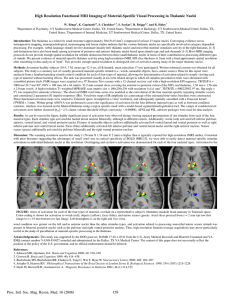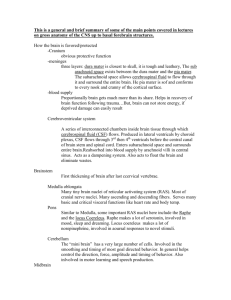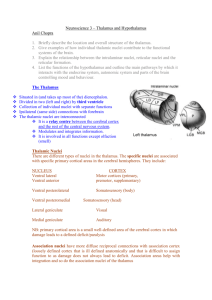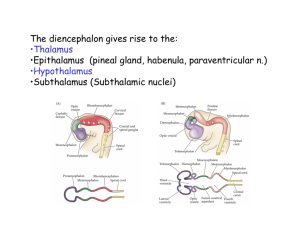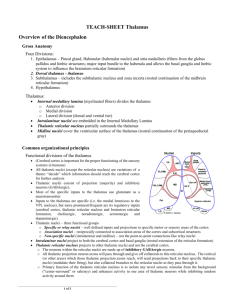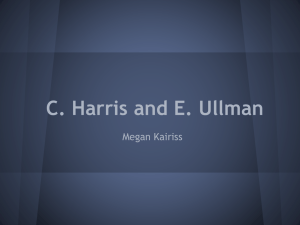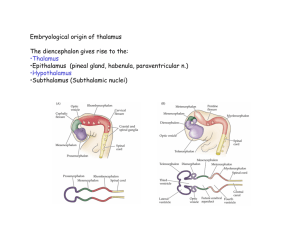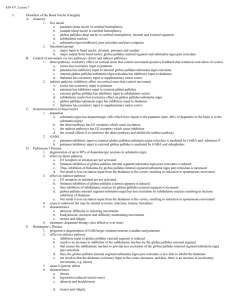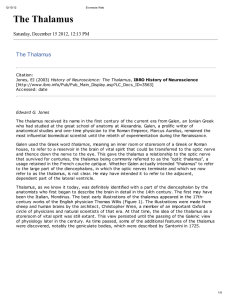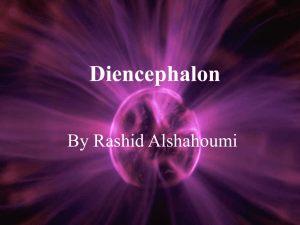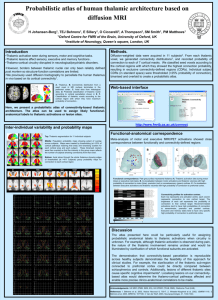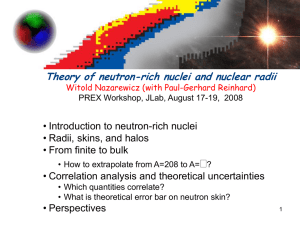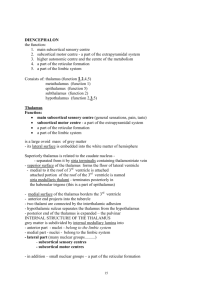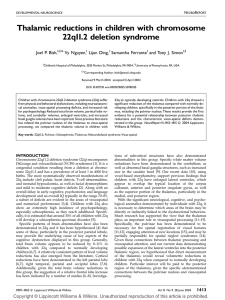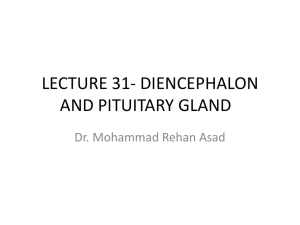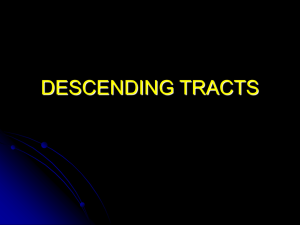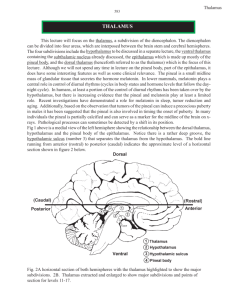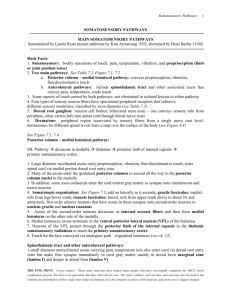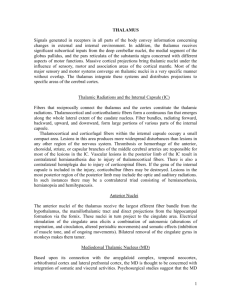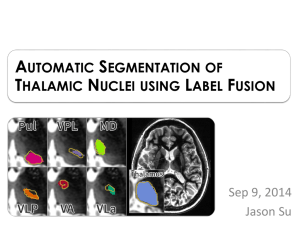THALAMUS AND BASAL GANGLIA
advertisement
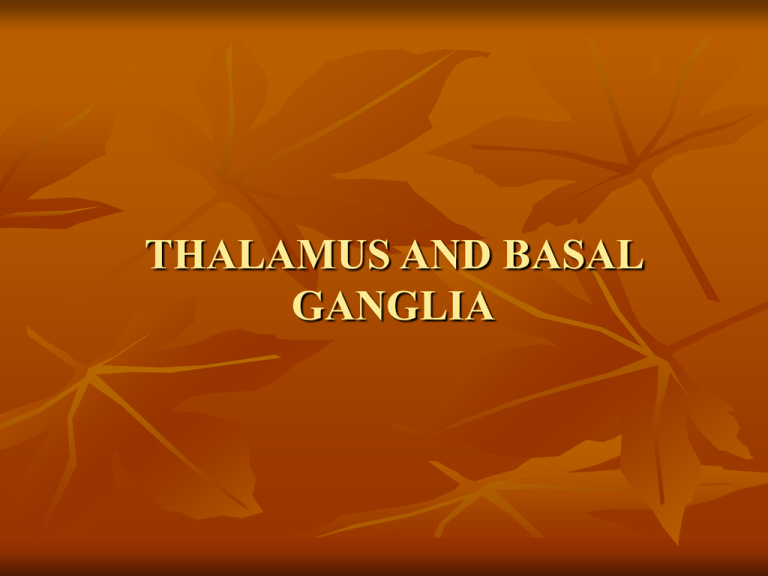
THALAMUS AND BASAL GANGLIA THALAMUS A group of nuclei in the wall of 3rd ventricle Largest structure in the diencephalon Bounderies -medial: third ventricle -lateral: posterior limb of internal capsule -dorsolateral: terminal sulcus -inferior: hypothalamic sulcus Cont’d Internal medullary lamina divides thalamus into ant., medial and lateral areas -ant. area: anterior nuclear group -medial area: dorsomedial and medline nuclei -lateral nuclei: dorsal and ventral tier Cont’d Ventral tier Dorsal tier -vent. Anterior -dorsolateral -vent. Lateral -lateral posterior -vent. Posterior -pulvinar Others: -intralaminar nuclei -reticular nuclei Four regions from diagnostic standpoint 1.The midline, intralaminar, reticular nuclei -nonspecific thalamic nuclei -mediate general cortical alerting responses -projections from midbrain RF, fibers from spinothalamic tract -project to midbrain and specific thalamic nuc -bilateral lesions cause impairment of conciousness Cont’d 2.The medial﴾ dorsomedial ﴿ and ant. thalamic n. -important role in memory and emotions -connected with hyypoth. and the “limbic lobe” -lesions associated with memory and executive function loss 3.The dorsolateral and post. nuclear groups -modulates occipito-temporo-parietal cortical attention -facilitates visual attention and the cortical attention needed for language related sensory tasks in the L. hemisphere and visuospatial tasks in the R.. cont’d 4.ventral lateral and basal nuclear groups -for processing and relay to the cortex of sensory information and sensorimotor control -ventral posterior nuclear group -medial geniculate body -lateral geniculate body VASCULAR SUPPLY From posterior cerebral and post. Communicating arteries Polar arteries Paramedian thalamomesencephalic arteries Thalamogeniculate pedicle Posteromedial choroidal arteries Posterolateral choroidal arteries LOCALISATION OF ISCHEMIC THALAMIC LESIONS Paramedian territory -due to embolic occlusion of top of basilar a. Or local atheroma -clinical triad of somnolent apathy , memory loss and abnormalities of vertical gaze Thalamogeniculate territory -ischemia around VP,VL nuc., subthalamic n. -hemianesthesia, transient slight hemiparesis ,hemiataxia, choreoathetoid mov’ts, paroxyxmal pain,homonymous hemianpopia Cont’d Tuberothalamic territory -due to thalamopolar a. lesions results in neuropsychological dysfunction Posterior choroidal a. territory -homonymous quadrantanopsia -hemisensory loss with mild hemiparesis -transcortical aphasia Thalamic hemorrhages One of the common sites of hypertensive h’ge Prominent sensory deficits Contralat. Hemiplegia or hemiparesis Aphasia after h’ge into dominant thalamus Homonymous visual field defects Ocular dysfunction Dejerine-Roussy syndrome Prognosis depends on amount and site of bleeding -ant. and dorsal types: usually benign -posteromed. and posterolat. types: poor prognosis BASAL GANGLIA COMPONENTS No generally accepted defination Considered to include 1.corpus striatum﴾ neostriatum﴿ -putamen and caudate nucleus 2.claustrum 3.substantia nigra: pars compacta and pars reticularis 4.globus pallides 5. subthalamic nucleus Cont’d Play a major role in the control of posture and movement Straitum- receptive component Globus pallidus – its internal seg’t, output str. Subthalamic – input from cer. cortex and reciprocal connection with G.P Substantia nigra- pars compacta: contain dopamine -pars reticulata :continuation of internal segment of globus pallidus connections Striatum receives three main inputs -excitatory input from cerebral cortex -excitatory input from intralaminar thalamic nuclei -modulatory input from substantia nigra PC. Striatal efferents -inhibitory GABAergic cells that project to the G.p and substantia nigra Cont’d Internal segment of G.P -project to three main targets -to thalamus -tosuperior colliculus -pedenculopontine nuclei of reticular form Output of B.G affects both corticospinal and brainstem motor pathways Lesions of B.G Subthalamic nuc.- contralat. Hemiballismuss Caudate nucleus- contralat. Choreoathetosis Globus pallidus-unilat.: contralat.hemidystonia ,hemiparkin. or tremor -bilat.:dystonia ,parkisonism abulia, akinesia Substantia nigra -parkinsonism Cont’d Two main types of disorders of B.G ·hyperkinetic﴾ dyskinetic ﴿ disorders -when dopaminergic mechs.exagerated ·hypokinetic ﴾akinetic ﴿disorders -when dopaminergic mechs. impaired Dyskinesias Chorea Tardive and orofacial dyskinesias Ballismus Athetosis, dystonia, torticollis Myoclonus Tics tremor Hypokinetic disorders Parkinsonism Corticobasal degeneration Progressive supranuclear palsy Multiple systems atrophy
